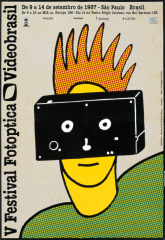- Fotoptica
- Museu da Imagem e do Som (São Paulo)
- Secretaria de Estado da Cultura de São Paulo
The gradual development and specialization of video production was clearly reflected in the Festival’s fifth edition, held in the Museu da Imagem e do Som. One such example was the presentation of “Uakti”, by Minas Gerais-born Eder Santos, who in the following years would become one of Brazil’s most prominent representative of the electronic art. The video clip, a little over six minutes long, features musicians from the homonymous group blending in with aquarium ornament in a seminal work that combines visual texturing, musicality, and camera interactivity. The award was extended to include technical categories, putting experimental videos and documentary films on center stage. Independent film companies, which by then already sold their work to commercial TV channels, screened a selection of their programmes. The new language made its first appearances on television. The parallel programme brought art work from the United States and Europe to Brazil. TV Cultura provided vast media coverage and a special show, increasing the amount of video broadcasts on television.
Visual identity and graphic design | Kiko Farkas and Paulo Labriola

Programme
competitive show
Competitive Show | 5th Festival
The Competitive Show of the 5th edition received 223 submissions, out of which 50 works by 71 Brazilian artists were shortlisted.
film and/or video screenings
"Multimídia", Ricardo Nauemberg
Ricardo Nauemberg, the video maker responsible for several opening vignettes to TV Globo’s soap operas, created a special edition of the Multimídia series for Globo’s Fantástico show. Music videos? Modern ballet on video? Video-poetry? Multimedia is multimedia.
Institutional Show
The exhibition featured the winners of the I Brazilian Corporate Video Festival, held during the II National Congress on Video Usage by Corporations. Video language also emerges as a major resource for internal and external promotion by enterprises.
International Show
The 5th Videobrasil saw the consolidation of the International Exhibition, an attempt to provide Brazilian audiences with a sample of video production from major hubs. In this Festival, the Exhibition featured video art pieces from France, Germany, Britain and the United States.
International Show: Ira Scheineder
The video exhibit featured five pieces by New York’s Ira Schneider, a leading member of the generation that created and decisively contributed to the development of video art worldwide.
Show of Videobrasil Festivals Winners
The exhibition featured winning works from the Festival’s last four editions, providing audiences with an overview of the evolution of video production in the country.
exhibition
"Anavedave", José Roberto Aguilar
A video installation by José Roberto Aguilar comprising a 35-minute VHS video, shown continuously inside a tunnel measuring 3x11 meters.
"Megaan Observa um Humano", Artur Matuck
This piece is a scientific vision, produced by the artist Artur Matuck, featuring alien characters who come in contact with human beings. Originally meant as a video, the piece was shown as a photo exhibit at the Festival.
"Teleshow by Dr. Sharp", Artur Matuck
An experimental video directed by the artist Artur Matuck, using Slow Scan equipment set up at the MIS’ facilities, and shown continuously during the Festival.
"The Uirapuru", Mauro Cícero
A video installation by Mauro Cícero composed of a video, broadcasting hypnotic information, shown in a naked TV tube, trapped inside a cage, like a lifeless electronic bird.
workshop
"I Vídeo Rallye/SP", with Luiz Algarra and Alberto Blumenschein
"I Vídeo Rallye/SP" was conceived as a workshop on video techniques for beginners interested in videotape image production, coordinated by Luiz Algarra and Alberto Blumenschein.
documentation
Bidirectional Transmission
A direct communication channel between the Festival and the XV Latin American Cinema and Video Journey in Bahia. The two-dimensional system was a project of the USP’s Art and Technology Research Institute, designed to combine the two cultural events in real time.